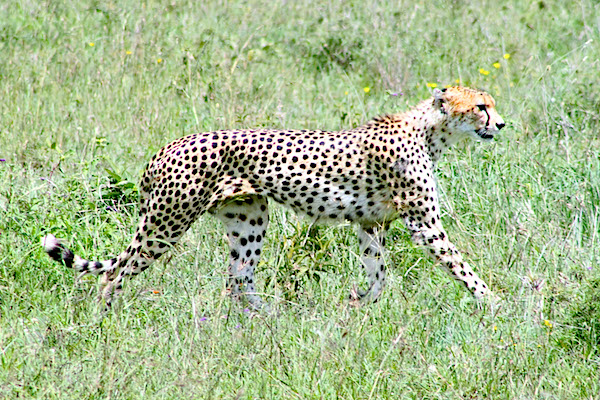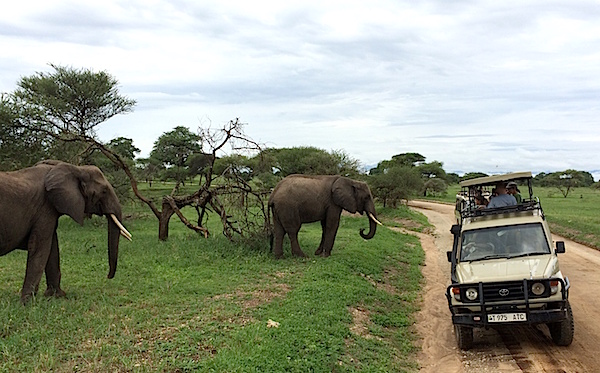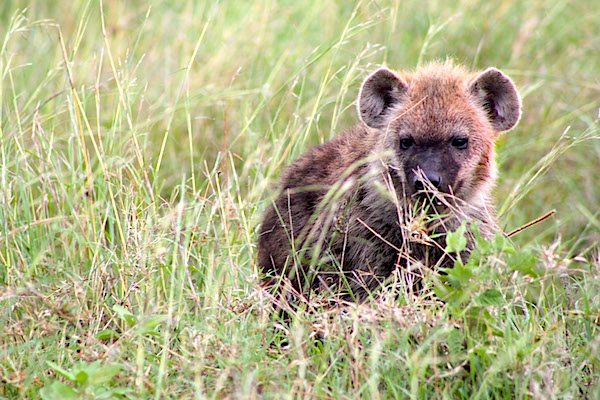 Safaris in national parks in Africa can lead to close encounters with wildlife, such as this cheeta/Sean Smith
Safaris in national parks in Africa can lead to close encounters with wildlife, such as this cheeta/Sean SmithEditor's note: Sean Smith is a former Yellowstone National Park ranger, and an award-winning conservationist, TEDx speaker, and author. He recently had the opportunity to visit some national parks in Tanzania, and returned home with thoughts of what the National Park Service might learn from its African colleagues.
I recently returned to the Northwest after a two-week Tanzanian safari. It was an amazing experience. The trip took us through Arusha, one of Tanzania’s larger cities, out to Tarangire and Serengeti national parks, and the Ngorongoro Conservation Area. The parks and conservation areas were filled with wildlife from the ubiquitous wildebeest to the rare black rhino.
African National Parks share many similarities with their American counterparts.
The parks are big. Serengeti, for example, is more than 3.7 million acres or roughly 1.5 times the size of Yellowstone. Put another way, Serengeti is larger than the state of Connecticut.
The parks are well-visited. Despite having to travel over many poorly maintained dirt roads, parks like the Serengeti and Ngorongoro see roughly 1 million tourists annually.
The parks protect natural and cultural resources. The Tanzanian Park Service, like its U.S. counterpart, protects both natural and cultural resources. Olduvai Gorge in the Ngorongoro Conservation Area protects one of the world’s most important historic sites and some of the oldest fossilized human remains. They like to say at Olduvai, if one traces his/her lineage back far enough, everyone is from Tanzania.
Yet, the Tanzania Park Service diverges from the U.S. National Park Service (NPS) on many issues. The African approach on several issues is an approach the NPS should copy.
Conservation over Recreation
The Tanzania Park Service places conservation and the protection of natural resources and wildlife over private recreation. Nearly every visitor to Tanzania’s national parks has a guide. These guides receive extensive training on resource and wildlife protection. The guides are taught to get the visitors deep into the parks for close-up but safe interactions with the wildlife. Private recreation such as hiking, mountain biking, and swimming is practically non-existent.
Yet, despite this focus on guided rather than private access, park visitors report high satisfaction with their safari adventures.

Elephants seemingly are habituated to humans and their vehicles/Sean Smith
Here in the United States, the NPS mistakenly promotes the idea that it has a dual mandate, one that requires the NPS to balance conservation with recreation. This is incorrect and the courts have consistently ruled that when there is a conflict between conservation and recreation, the law requires the Park Service to favor conservation. The Park Service’s continued pushing of the dual-mandate myth creates undue management headaches, as every recreation interest from snowmobiles to off-lease dog walkers demands access to the national parks. As a result, the national parks are compromised by questionable activities that in many instances do not require a national park setting to enjoy.
Africa takes conservation crimes seriously
Tanzanian park rangers and their African counterparts take environmental crimes seriously. During our safari, I asked our guide if the truck broke down, how would we contact the rangers for help? Our guide responded, “We wouldn’t. The rangers' job was to patrol the borders looking for poachers. We would have to get ourselves up and running again.”
This focus on poaching was recently rewarded when Tanzanian police arrested Feisal Muhammad Ali, the world’s most-wanted ivory trafficker. Meanwhile, rangers in South Africa shot and killed suspected rhino poachers. While I’m not advocating for the summary execution of park criminals, the U.S. government could do more to increase the understanding of the severity of environmental crimes. However, its handling of the Cliven Bundy standoff in Nevada and the courts' unwillingness to impose stiff penalties for poaching sends the message that resource crimes are no big deal.

Hyena in the grass/Sean Smith
Focus on experiences
Another area of focus for the Tanzania park rangers is a on visitor experience rather than amenities. To say the roads of Serengeti and Ngorongoro are rough is an understatement. In some instances, park roads are little more than a mud streak. Meanwhile, the Tanzanian national parks spend little on so-called necessities such as Wi-Fi and cellphone coverage. Interpretive displays are often rudimentary and lack any high-tech whiz bang features found in the United States. However, they provide information in multiple languages, increasing public understanding of why the parks are important.
Rather than providing distractions, the Tanzanian parks focus on preserving authentic experiences. An authentic experience is one that improves a visitor’s appreciation and understanding of park wildlife and natural features, while allowing low-impact intimate interaction with those resources. Unfortunately, many U.S. park activities significantly diminish authentic experiences.
America’s National Park Service will celebrate its 100th birthday in 2016. During the upcoming year, it’s expected the NPS will seek public comment on how best to ensure the park system and Service reach their bicentennial. The agency should look to Africa for guidance.
Sean Smith is a former Yellowstone Ranger, and an award winning conservationist, TEDx speaker, and author. He writes national park thrillers from his home in the shadow of Mount Rainier National Park. To learn more about his conservation work and novels, check out his blog: www.seandavidsmith.blogspot.com or follow him on twitter: @parkthrillers



Comments
When and where has the NPS increased access?
This is from an article in the British Independent website by Robert Fisk, a famous war correspondent who spent much of his life in Lebanon. For some reason it reminded me of some (not all) of the comments on NPTraveler. It applies to many comments on the internet which I think is dumbing down the whole world. Hope I haven't offended anyone who doesn't deserve it.
"As Alain de Botton’s Philosopher’s Mail – a web-based newspaper with all the old-fashioned principles of literacy – points out, “the ability to post comments at the end of online news stories has revealed something unusual about our fellow citizens: even though most of them seem really quite nice and very polite when we meet them… they are” – when commenting online – “very different: jealous, furious, vindictive, heartless, obsessive, unforgiving and a little short of insane.”"
Thanks, Roger. Much truth in that :-)
Good point, Roger. We're all insane. In the old days, you had to write a formal letter to the editor, who would reject it if you were insane. You had to sign it with your real name and give your address and phone number. Now anyone can pick a pseudonym and have at it. Off with his head! Still, I find it a valuable process, especially for those who might suffer the consequences of expressing their views in public. We can only hope that those using pseudonyms on The Traveler need to use them. Otherwise, I am delighted when people step forward and sign.
So back to the discussion. Ageed, I can think of no instance in recent history when the National Park Service built a "new" road, but yes, I can think of many that have been widened and straightened. And let us not forget all of the reports on these pages of the parking lots being expanded and "improved." Wasn't Arches National Park recently cited there? Time gets away from us all, but I was in Grand Teton when the Jenny Lake "complex" was completed, including the huge parking lot that is there now. As for Yellowstone, I have pictures of the road widening and straightening there, including all of the new embankments strewn with "decaying" logs. In 1959, when my mother took us west, all of the speed limits were 35 mph. The biggest private vehicles in the parks were Airstream trailers. Now most of Yellowstone is 45 mph, but really, 60 mph is the norm. You don't believe me? Just try going 45 mph when a tour bus has a "schedule" to make. A century ago, it took five days to see the park by stagecoach. Now many brag they see it in one. Again, what's the difference between here and Africa? As this article says, it is the ROADS, in Sean's description, little more than "a mud streak." Navigating those mud streaks takes commitment and TIME.
With wildlife, you have to be patient. Dramatic scenery is always there. Because our parks were designed for dramatic scenery, we are still scrambling to catch up with TIME. I love railroads because they remind us of that. Why shouldn't we spend three days crossing the country? Exactly what are we to do with the time we "save" by flying?
But that's not our culture. Way back in 1830, Alexis de Tocqueville, writing DEMOCRACY IN AMERICA, noted that we Americans would gobble down dinner and instantly bolt the table, even if we had nowhere else to go. We're always in a rush. We don't want to miss a thing. That's not all of us, but it certainly infects all of us. And so, along with kissing our railroads good-bye, we have "speeded up" everything in our national parks. Need to call home, ET? No problem. The new cell phone tower just went in.
This thread is amazing. I'm in agreement with Mr Runte twice and G. Wilson once. Quick, I'm putting a star on my calendar.
Speaking of roads traversing Wilderness, remember the Mineral King Road
Proposals eventually leading to a south Sierran transhighway through SEKI ?
What did The NPS do to stop this proposed crime against wilderness values ?
Mineral King: Public concern with government policy Paperback
– 1982 by John L Harper
The Sierra Club sued, the case went to the Supreme Court twice. In the end, Disney backed away, Mineral King was included in Sequoia National Park and the alpine ski proposal died a well deserved death. With development of Disneyland in 1955, surrounding businesses earn more money off of Disney than Disney does itself. Disney vowed not to let that happen again, including at an alpine ski area. Disney tried again at Independence Lake north of Lake Tahoe - and again failed because they could not obtain complete control.
http://southland.gizmodo.com/a-mountain-disneyland-how-disney-almost-bui...
http://www.mineralking.org/Mineral_King_Road_Cooridor/The_New_Road.htm
http://www.disunplugged.com/2012/09/09/mineral-king-walt-disneys-last-lo...
http://www.mk-webcam.net/
As mentioned previously, several of us, including Dr. Runte, have worked at one time or another during our careers in Yosemite National Park.
Reading the above thread of commentary, I'm reminded of a special training session held during the summer of 1970 for our professional staff of seasonal park ranger-naturalists. This training session was held at Glacier Point by our Chief Naturalist William R. (Bill) Jones.
After Bill introduced us to the geological forces that formed the Yosemite and the glacial erratics deposited on Glacier Point, Dr. Carl W. Sharsmith intervened to express a personal concern. Dr. Sharsmith talked at length about increasing "improvements" compromising the pristine back country of Yosemite. He talked in a rather soft baritone voice about the encroachment of infrastructure during the (at that time nearly 5) decades he had worked in the park. Dr. Sharsmith described the new concession stables with highly reflective metal roofs visible from the summits of many of the high peaks, the enlarged parking areas at Tuolumne Meadows, the widening and straightening of the otherwise "optimum" Tioga Pass road. When he finished, Dr. Sharsmith asked Bill Jones, "When will it stop?" What followed was only prolonged silence.
Often, carrying capacities for parks should be determined as much by aesthetic considerations as the potential to impact fragile ecosystems. Carrying capacities in parks are quite difficult to establish, let alone enforce, when such actions, invoked to protect the scenery and the wildlife therin, impact local and regional economies.
Dr. Runte and Dr. Hoffman -- both right. Unfortunately.
Again -- what's to be done about it given the realities our parks face. Just try limiting access in any way and the explosion will be of far greater magnitude than Mt. St. Helens.